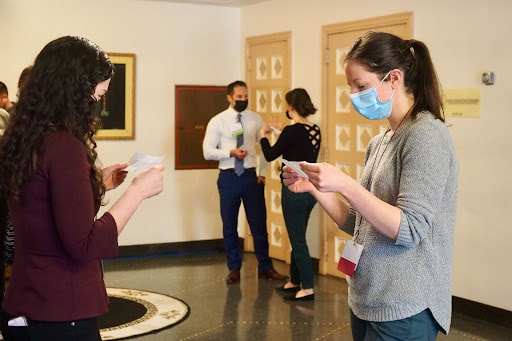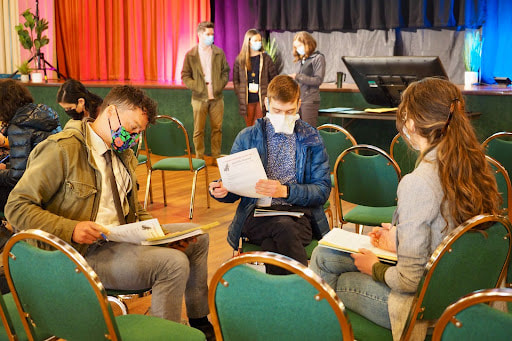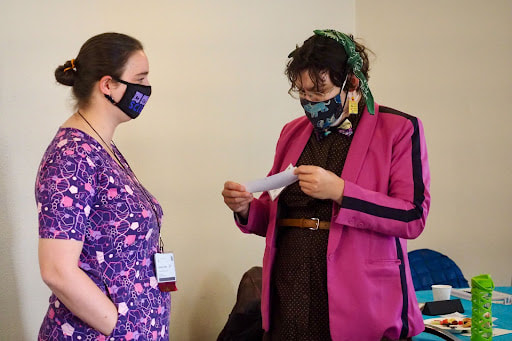At Science Talk 2022, hundreds of science communicators from around the world shared their expertise and made new connections. In my previous post, I wrote about my experience meeting fellow science communicators in person for the first time. Today, I’m going to share my personal takeaways from the workshops and talks at the conference. Out of the many good ideas bouncing around at the sessions, I noticed three themes that came up again and again: know your audience, be empathetic, and choose your messenger wisely.
Know Your Audience
When acquaintances ask me to define “science communication,” I generally say something about “bridging the gap between scientists and the public.” The truth is, there is no such monolith as “the” public. Are you communicating with white evangelical Christians in Texas? Science-interested college-educated liberals in California? Middle-class Muslim women in Pakistan? All these audiences hold differing values, live in different cultural contexts, and have potentially different levels of background knowledge in the topic you hope to address.
In their virtual talk “Helping Scientists Maximize Impact with SciComm,” Sheeva Azma and Nidhi Parekh gave an excellent example of culturally relevant scicomm. The “bread exam” video by the Lebanese Breast Cancer Foundation shows a traditional Lebanese baker kneading and pressing dough, demonstrating to fellow Lebanese women how to examine their breasts for lumps. The video leverages the audience’s familiarity with breadmaking while avoiding any mention of taboo concepts.
Delivering the opening keynote, Sheril Kirshenbaum highlighted potential disconnects between what we might consider common knowledge and what our audience actually knows. For instance, in 2018, 49% of US consumers agreed with the statement “all food with deoxyribonucleic acid should be labeled.” If your audience does not realize that all food contains DNA, you’ll need to establish that background before launching into a discussion of GMOs, CRISPR, or organic food.
Betsi Oliver, who presented a short talk on her work building community partnerships in Alaska, urged us to reframe the goals of our science communication projects. Instead of asking ourselves “What product do I want to make?”, she said, we should ask ourselves “What outcome do I want to achieve?” First and foremost, that means meeting our audiences where they are.
Be Empathetic
As social science research on cognitive biases has shown, facts alone are typically insufficient to cause people to change their attitudes or behaviors. Instead of shouting from the rooftops that COVID vaccines are safe and effective, we need to take the time to understand the nuanced and often justified reasons why someone might be reluctant to get vaccinated—then validate their feelings and find values in common.
Jennifer Ma gave an excellent talk on “Compassionate Science Communication in Practice,” which she summarized here in a pair of blog posts. Using the case study of her Instagram project “Gentle Facts,” she walked us through a four-step process for engaging with vaccine-hesitant audiences: listen, relate, inform, encourage.
The importance of empathy also came up in a SciTalk ’22 workshop on “Communicating with Science Averse Audiences.” The workshop, led by three PhD candidates at the University of Washington, gave attendees the opportunity to role-play stressful conversations we might have as science communicators. First, we addressed a heckler disrupting a presentation. Then, we practiced one-on-one conversations with individuals who disagreed with us. In the latter situation, the first step was to ask open-ended, nonthreatening, non-leading questions. Second, we had to accurately restate the other person’s viewpoint and try to find common ground. Only after accomplishing these two steps could we share our own perspective with our interlocutor.

As an aspiring climate communicator, I found the workshop incredibly relevant and helpful. The role-playing exercises gave me a framework for approaching difficult scicomm scenarios with empathy, a skill that I hope to continue developing in the coming years. Plus, “be empathetic” is not just good scicomm advice—it’s good advice for all of life.
Choose Your Messenger Wisely
You may be an expert in your science, an expert communicator, or both—but that doesn’t necessarily make you the right person to deliver the message, especially on a potentially controversial topic.
At SciTalk ’22, I attended a workshop called “‘We’re the government and we’re here to help:’ Disaster recovery communications.” Three Oregon government officials talked about their experience communicating with residents in the aftermath of the state’s devastating fires in fall 2020. Unsurprisingly, many of the communities they wanted to reach were distrustful of government figures—especially when officials said that beloved trees on many people’s properties were now hazardous and needed to be removed.
The speakers explained how they first worked to build trust with community leaders. Then those community leaders carried the message to other Oregonians. In the workshop, we broke into groups to practice honing a message and identifying the messenger who could most effectively reach our target audience.

The importance of the messenger was also featured in the panel discussion “Communicating Science in Español: Reaching a Global Latinx Spanish Audience.” The speakers pointed out that literal translations of scicomm content are much less likely to resonate with their audience than translations that incorporate appropriate cultural references. That means that the translator should understand the relevant culture—even better if they are a member of the community.
It can be difficult to admit that we, despite our expertise, are not always the best messengers. But if we scicommers think of ourselves as network builders, as Betsi Oliver does, we can take heart that forming community partnerships will facilitate a much deeper impact than working alone would.
Putting the Pieces Together
As Science Talk ’22 helped me see, these three aspects of effective science communication—audience, empathy, and messenger—are closely interrelated. Without understanding your audience, you cannot hope to be truly empathetic or pick the best messenger. The bottom line for me is that we should center our science communication on our audience’s needs and values rather than our own.
The conference gave me an abundance of ideas to ponder, resources to peruse, and friendships to cultivate. I found it invigorating and inspiring to see all of the great work that our community is involved in.

Let us know in the comments what you have learned recently about scicomm, whether you picked it up at SciTalk ’22 or encountered it elsewhere in your scicomm journey. I hope to see you all at SciTalk ’24!
Registration is now open for Science Talk 2024!



Leave a Reply